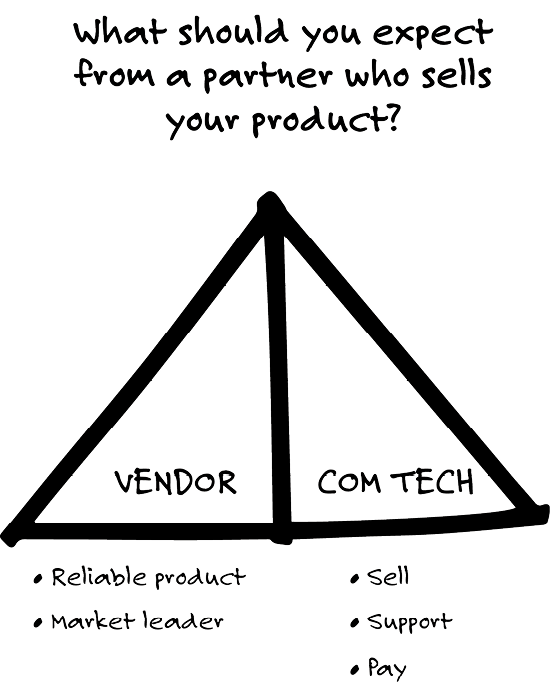
Chapter 6
Taking care of business partners
As I have said before, a good partnership works when both parties add value to each other.
At Com Tech I knew what I expected from the suppliers that we worked with, and at the same time I recognised what they should expect from us as their distribution partner in Australia.
To keep the two triangles equal, I needed my suppliers to provide us with an industry-standard, market-leading product. If anything changed, the triangle would no longer be balanced. This happened on many occasions during my tenure as founder of Com Tech. The toughest one was telling Novell that I was going to sign a distribution agreement with Novell’s arch-enemy, Microsoft. Novell had put me on the map, given me the opportunity of a lifetime and had helped to make Com Tech the company that we were.
When I signed with Novell in 1989, they were the dominant player in local area networking – commanding 70 per cent market share. They were growing 40 per cent year on year and so were we. By 1996, that market share had been severely eroded by Microsoft. At that stage, we were the exclusive distributor for Novell. In 1989, the biggest risk to our business was that we were one of four Novell distributors in Australia – all selling an identical product into the Australian marketplace. The only way that we could differentiate ourselves was by the people selling and supporting their products. By 1996, the biggest risk to our business was that we had become Novell’s exclusive distributor – all the others had disappeared. Microsoft was killing Novell, and if we didn’t sign a distribution agreement with Microsoft we would become irrelevant. Novell was dying and we didn’t have to die with them. The triangle was no longer balanced – Novell added no value to Com Tech.
Although by nature I’m a very loyal person, I signed with Microsoft. I wasn’t going to let down the 240 people who worked at Com Tech. I was the CEO of Com Tech – Novell’s problems were their problems; I couldn’t make their problems our problems. In 1989, Novell was 80 per cent of our business. When I left in 2001, it accounted for 0.8 per cent of our business. If we hadn’t made that change, Com Tech would not have achieved the outcome that we did when we sold for an enterprise value of over $1 billion. Sometimes the right decision is the hardest decision.
So, if we expected our vendors to keep investing in product and marketing to ensure that they retained their dominant market position, what should they have expected from us? When someone appoints you as their partner, they are essentially outsourcing a part of their business that they could have done themselves. You outsource because you believe that party is going to do at least as good a job as you would have done for the parts of your business you’ve entrusted them to carry out on your behalf.
To keep our vendors happy, we needed to:
1. sell lots of their product,
2. support the product as well as they would, and
3. pay our bills on time.
It was no use doing two out of three, we had to deliver on all three. Say our budget with Cisco was $100 million. If we did $70 million, provided legendary support for their product and paid our bills on time – we had let them down. We had missed our budget by $30 million. Likewise, it would have been no use doing $130 million, going broke and then being unable to pay our outstanding bills. Partnerships work when BOTH parties deliver on all of their commitments. That’s how you keep the triangle balanced.
Afterpay has been a massive success, both with retailers and their customers. Retailers can see that by using Afterpay their basket size and conversion rates grow, while the end customer loves getting access to their purchase without having to lay out all the cash up front. Simple, but beneficial to both parties.
As a founder, you need to constantly assess what you expect from your partners and what your partner expects from you. When both sides deliver on their obligations, partnerships work.
• • •
